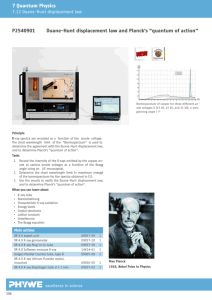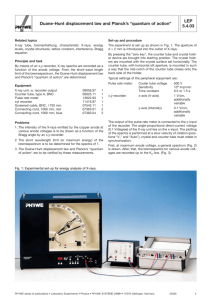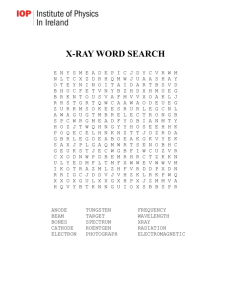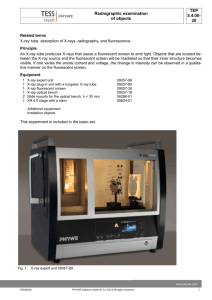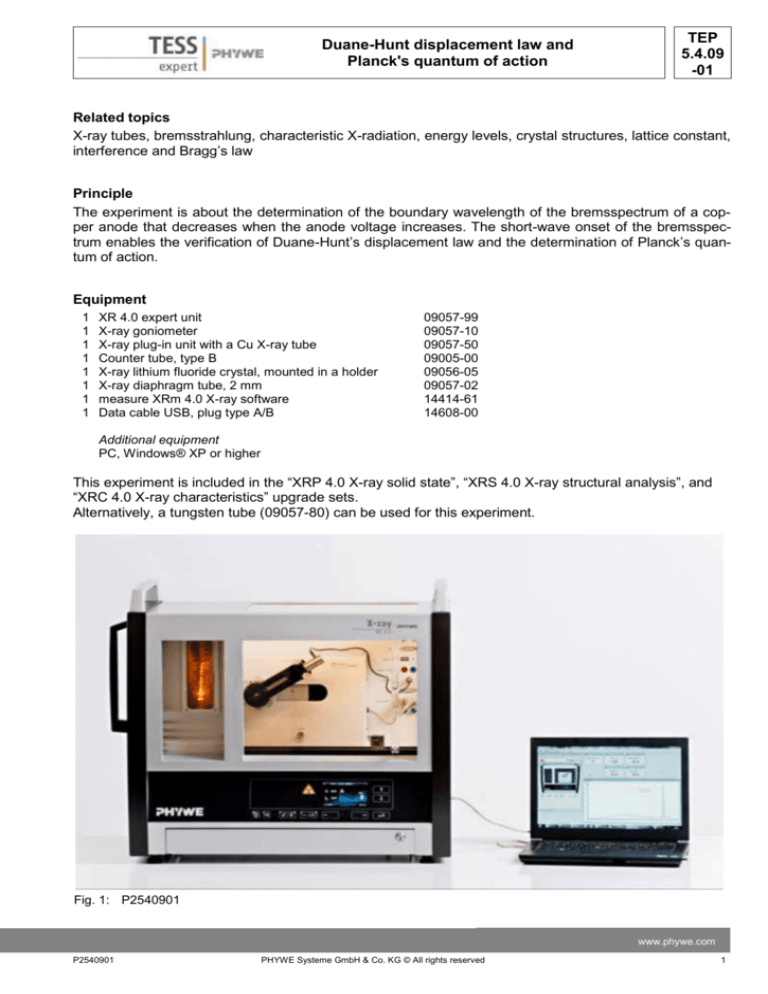
Duane-Hunt displacement law and
Planck's quantum of action
TEP
5.4.09
-01
Related topics
X-ray tubes, bremsstrahlung, characteristic X-radiation, energy levels, crystal structures, lattice constant,
interference and Bragg’s law
Principle
The experiment is about the determination of the boundary wavelength of the bremsspectrum of a copper anode that decreases when the anode voltage increases. The short-wave onset of the bremsspectrum enables the verification of Duane-Hunt’s displacement law and the determination of Planck’s quantum of action.
Equipment
1
1
1
1
1
1
1
1
XR 4.0 expert unit
X-ray goniometer
X-ray plug-in unit with a Cu X-ray tube
Counter tube, type B
X-ray lithium fluoride crystal, mounted in a holder
X-ray diaphragm tube, 2 mm
measure XRm 4.0 X-ray software
Data cable USB, plug type A/B
09057-99
09057-10
09057-50
09005-00
09056-05
09057-02
14414-61
14608-00
Additional equipment
PC, Windows® XP or higher
This experiment is included in the “XRP 4.0 X-ray solid state”, “XRS 4.0 X-ray structural analysis”, and
“XRC 4.0 X-ray characteristics” upgrade sets.
Alternatively, a tungsten tube (09057-80) can be used for this experiment.
Fig. 1: P2540901
www.phywe.com
P2540901
PHYWE Systeme GmbH & Co. KG © All rights reserved
1
TEP
5.4.09
-01
Duane-Hunt displacement law and
Planck's quantum of action
Tasks
1. Record the X-ray spectrum that is emitted by the copper anode at various different anode voltages
UA as a function of the Bragg angle ϑ and with the aid of a LiF monocrystal as the analyser.
2. Determine the short-wave onset (λmin) of the bremsspectra.
3. Use the results to verify the Duane-Hunt displacement law,
and to determine Planck's "quantum of action".
Set-up
Connect the goniometer and the Geiger-Müller counter tube to
their respective sockets in the experiment chamber (see the red
markings in Fig. 2). The goniometer block with the analyser crystal should be located at the end position on the right-hand side.
Fasten the Geiger-Müller counter tube with its holder to the back
stop of the guide rails. Do not forget to install the diaphragm in
front of the counter tube (see Fig. 3).
Insert a diaphragm tube with a diameter of 2 mm into the beam
outlet of the tube plug-in unit for the collimation of the X-ray beam.
For calibration: Make sure, that the correct crystal is entered in
the goniometer parameters. Then, select “Menu”, “Goniometer”,
“Autocalibration”. The device now determines the optimal positions of the crystal and the goniometer to each other and then the
positions of the peaks.
Fig. 2: Connectors in the experiment
chamber
GM-counter
tube
Goniometer at
the end position
Diaphragm tube
Counter tube
diaphragm
Mounted
crystal
Fig. 3: Set-up of the goniometer
2
PHYWE Systeme GmbH & Co. KG © All rights reserved
P2540901
TEP
5.4.09
-01
Duane-Hunt displacement law and
Planck's quantum of action
Note
Details concerning the operation of the X-ray unit
and goniometer as well as information on how to
handle the monocrystals can be found in the respective operating instructions.
Procedure
- Connect the X-ray unit via USB cable to the
USB port of your computer (the correct port of
Fig. 4: Connection of the computer
the X-ray unit is marked in Fig. 4).
- Start the “measure” program. A virtual X-ray unit
will be displayed on the screen.
- You can control the X-ray unit by clicking the
various features on and under the virtual X-ray
unit. Alternatively, you can also change the parameters at the real X-ray unit. The program will
automatically adopt the settings.
- Click the experiment chamber (see the red
marking in Figure 5) to change the parameters
for the experiment (e.g. the goniometer).
- If you click the X-ray tube (see the red marking
in Figure 5), you can change the voltage and
For setting the
current of the X-ray tube. First record an entire
For setting the
goniometer
spectrum (4-55°). Then, record the spectra up to
X-ray tube
the Kβ line (scanning range 4-22°) with an anode current of 1 mA and a voltage range of 1333 kV in steps of 2 kV.
- Start the measurement by clicking the red circle
Fig. 5: Part of the user interface of the software
-
-
-
After the measurement, the following window
appears:
Select the first item and confirm by clicking OK.
The measured values will now be transferred
directly to the “measure” software.
At the end of this manual a short introduction to
the evaluation of the resulting spectra is given.
Overview of the settings of the goniometer and
X-ray unit:
- Auto and 2:1 coupling mode
- Gate time 2 s; angle step width 0.1°
Recording of the entire spectrum:
- Scanning range: 3°-55°
- Anode voltage UA = 35 kV; anode current
IA = 1 mA
Bremsspectra up to the characteristic Cu Kβ line
(n = 1) as a function of UA:
-
Scanning range: 4°-22°
-
Anode voltage 33 kV > UA > 13 kV,
ΔUA = 2 kV; anode current IA = 1 mA
-
Note
Never expose the Geiger-Müller counter tube to the primary X-radiation for an extended period of time.
www.phywe.com
P2540901
PHYWE Systeme GmbH & Co. KG © All rights reserved
3
TEP
5.4.09
-01
Duane-Hunt displacement law and
Planck's quantum of action
Theory
Due to the voltage UA between the anode and
cathode, the electrons are accelerated from the
cathode towards the anode. At the cathode, the
electrons have the following energy:
Ekin eU A (e = elementary charge)
(1)
Due to interactions with the atoms of the anode
material, the electrons gradually lose their kinetic
energy, which is converted into a continuous X-ray
spectrum (bremsspectrum). If the kinetic energy is
lost in one step, X-rays with maximum energy (minimum wavelength min) are generated. In 1915, the
American physicists Duane and Hunt found that
the product of the accelerating voltage, and of the
Fig 6: Goniometer settings for recording the bremsspectra (task 2)
minimum wavelength, is constant:
U A min 1.25 10 6 V m
(2)
The energy equation:
Ekin e U A h f max h
c
(3)
min
h =6.6256∙10-34 Js
Velocity of light
c =2.9979∙108 m/s
Elementary charge e =1.6021∙10-19 As
Planck's constant
leads to:
min 1.2398 10 6
1
V m
UA
for the shortest wavelength of the X-ray photons.
A LiF monocrystal is used for the wavelength analysis of the X-rays. When the X-rays impinge on the lattice planes of the monocrystal under the glancing angle ϑ, the rays that are reflected interfere with each
other in a constructive manner provided that their path difference corresponds to an integral multiple of
the wavelength. In this case, Bragg’s law applies:
2d sin n
(4)
(LiF (200) interplanar spacing d = 201.4 pm; n = 1,
2, 3, ....)
Evaluation
Task 1: Record the X-ray spectrum that is emitted
by the copper anode at various different anode
voltages UA as a function of the Bragg angle ϑ and
with the aid of a LiF monocrystal as the analyser.
Figure 7 shows the entire bremsspectrum of the
copper anode. Figure 8 only shows the section that
is of interest for further evaluation, based on three
4
Fig. 7: X-ray spectrum of copper; LiF analyser crystal
PHYWE Systeme GmbH & Co. KG © All rights reserved
P2540901
TEP
5.4.09
-01
Duane-Hunt displacement law and
Planck's quantum of action
Fig. 8: Bremsspectrum of copper for three different anode voltages UA (15 kV,
25 kV, and 31 kV), x-axis: glancing angle ϑ /°
different anode voltages. When the anode voltage is
increased, the onset of the bremsspectrum is shifted
towards smaller glancing angles, i.e. towards shorter
wavelengths.
Task 2: Determine the short-wave onset (λmin) of the
bremsspectra.
The short-wave limit λmin of the bremsspectrum is
determined by the associated glancing angle and it
can be calculated with the aid of equation (4).
Task 3: Plot the functions λmin= f(1/ UA) and sin
ϑmin= f(1/ UA). Calculate Planck’s quantum of action.
Figure 9 shows the λmin values that were determined
based on the bremsspectra as a function of 1/UA.
Fig. 9: Duane-Hunt displacement law; λmin = f(1/UA)
The value of the gradient m of the resulting straight
line confirms the relationship in accordance with
Duane-Hunt’s law of displacement, equation (2):
m
min
1/U A
(12.20 0.07) 10 5 V m
Planck’s quantum of action can be determined with
the aid of the family of bremsspectra. (3) and (4)
lead to:
UA
hc
2e d sin
(5)
(5)
If sin ϑmin is plotted as a function of 1/UA, a straight
Fig. 10: Planck's quantum of action:
sinϑmin = f(1/UA)
www.phywe.com
P2540901
PHYWE Systeme GmbH & Co. KG © All rights reserved
5
TEP
5.4.09
-01
Duane-Hunt displacement law and
Planck's quantum of action
line results (see Figure 11). The gradient of this straight line can be obtained from Figure 10:
m
hc
2e d
With the experimental value of m = (2.986)∙103 pm.V, the following results for Planck’s quantum of action:
h
m2ed
h
6.43 10 34 Js;
3%
c
h
Evaluation of the measurements with the aid of the “measure” software
In order to evaluate the measurements with the aid of the “measure” software, first convert the glancing
angles ϑ (crystal angle = x-axis) of the spectra into the corresponding wavelengths. To do so, proceed as
follows:
1. “Analysis”, “X-ray spectroscopy”, “Convert x-axis”, and “Wavelength (calculate)”.
The Duane-Hunt line can be obtained from the converted spectra (Imp/s = f(lamdba/pm) as follows:
2. Click “Analysis”, “X-ray spectroscopy”, and “Duane-Hunt straight line”. The window “Duane-Hunt
straight line” appears.
Then, select the onset of the bremsspectrum as a narrow band with the aid of the marker and click
“Accept value”. The additional window then shows the corresponding values for the anode voltage
and wavelength. Repeat this for the other spectra with different anode voltages.
In order to generate the straight line, click “Generate Duane-Hunt line”.
Planck’s quantum of action can be determined by clicking “Analysis”, “X-ray spectroscopy”, and “Determine Planck constant” (see Fig. 11).
With “Display options”, “Channels”, and “Symbol”, the measuring points of the Duane-Hunt line can
be displayed if desired.
Refer to the Help of the “measure” software for additional, more detailed explanations concerning the
program features.
Fig. 11: Duane-Hunt line with the automatic calculation of the Planck’s constant
6
PHYWE Systeme GmbH & Co. KG © All rights reserved
P2540901

